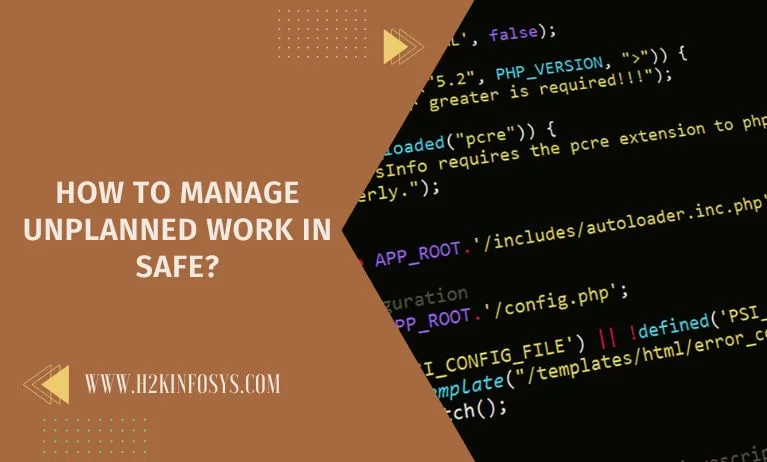The most widely used framework for scaling Agile teams continues to be the Scaled Agile Framework® Manage Unplanned Work in SAFe. SAFe is not flawless by any means, despite its widespread use; no framework is ideal in every circumstance.
Unplanned work is probably a typical occurrence for any organisation striving to adjust to an increasingly dynamic business environment, but SAFe lacks a prescribed method for handling it. While SAFe does not offer detailed advice on how to handle unforeseen surprises, there are a few components of the framework you may use to lessen their negative consequences. Check out the Agile Scrum master certification course to learn more about managing Unplanned work in a SAFe.
What is “Unplanned Work”?
It’s important to define “unplanned work” up front before exploring SAFe management methods for unplanned work.
For the purposes of this article, let’s suppose that “unplanned work” refers to new requirements that have emerged during the execution of a Program Increment (PI), either as a result of input from stakeholders or as a result of unanticipated business circumstances. “Unplanned work” in this context excludes “discovered” work, which refers to certain tasks that the team discovers throughout the PI that must be completed to complete a previously planned Feature or Capability. Although the approaches taken to deal with either situation may be comparable, we’ll concentrate on the first definition for the sake of simplicity.
What Does Success Look Like?
Any Agile endeavour must have good change management skills. Whether you use Manage Unplanned Work in SAFe or not, your team needs to be able to deal with unforeseen circumstances politely if you want to keep your word. What does “success” entail in this situation, then?
Despite changes in the business environment that may result from client or competitor conduct, the management of unforeseen events often correlates to effective value delivery. Therefore, you will be able to increase your chances of successfully achieving the PI Objectives and business goals if your team is effective in handling changes in their backlog.
Techniques for Dealing With Change
There isn’t much advice available to help your team manage requirements changes if you’re using SAFe. You can find some helpful hints if you look at some of the advice more carefully, though.
1,Keep an eye on how much requirements volatility changes.
Establishing and maintaining a statistic called requirements volatility (which you may not be familiar with) is one of the keys to managing shifting needs. Although it is a leading indicator, this metric is comparable to predictability in that it allows your Agile Release Train (ART) to monitor the rate of change in your needs.

For sustaining and managing work at different levels, Manage Unplanned Work in SAFe has a number of backlogs, with the Portfolio Backlog at the top of the hierarchy. When using Portfolio-level SAFe, the majority of teams will use this backlog to manage the high-level business requirements, which are typically defined in the form of business cases or projects. Since there is no “baseline” or “freeze period” that takes place, it might be challenging to gauge the amount of change that is taking place because this backlog, like all the others, is meant to be organic and constantly evolving. This implies that you must choose a moment in time and evaluate the degree of change in order to deploy a metric like requirements volatility.
2.Measuring Volatility
When might the most appropriate intervals to capture pictures be? As I previously stated, SAFe does not offer any advice on this subject, but one strategy that I have seen to be successful is to conduct measurement at PI borders (at the very least) in order to assess how much change has taken place within the backlog. You can then count the number of additional prerequisites or epics that have been added during that time.

If your PI’s priorities are changing significantly, you might wish to perform the same measurement at the program level (inside the Program backlog). If you see significant changes in requirements that are unwelcome and potentially harmful to your ART, you might also do the same for the Team-level backlog.
Although there will probably be a cost involved in measuring and tracking the volatility of requirements, you might notice trends that change how work is introduced and/or prioritised, which is a crucial component that could determine the efficacy of the ART.
3.Allocating Capacity to Address Unexpected Change
Capacity Allocation of your backlogs is an additional strategy you might take into account for managing demand. You can choose how to arrange and schedule your work within the backlog at each level of SAFe to guarantee the best possible balance between Enablers, Features, and Technical Debt. This enables you to provide both the fundamental infrastructure and short-term value that you will need in the future.
If your stakeholders have a propensity to change priorities frequently or unexpectedly, having the extra capacity to handle these situations can improve your teams’ ability to continue delivering useful system capabilities. One strategy you could consider is to encourage your teams to only plan up to 80% of maximum capacity in order to provide a buffer for expected changes in requirements.
One suggestion in this circumstance is to keep teaching your stakeholders and consumers about needs management; make them comprehend that frequent change is not desirable and may even be harmful. Even if your staff is able to handle this efficiently, it is not a long-term solution and is bad for morale.
Conclusion
There is no ideal method for handling unforeseen work, even though we are all aware that change is inevitable and ought to be welcomed. Relationships play a big part in how we experience change; ultimately, how well we collaborate with clients, stakeholders, and teams will decide the success of any project. You can apply for the Agile project management certification course to learn more.





























